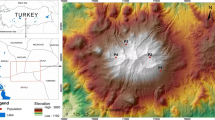Abstract
Turkey, which is a very rich country in terms of medicinal and aromatic plants including sage, is one of the world’s leading gene sources. Thyme and sage that is the medicinal and aromatic plant are naturally grown in the Aegean region. In the present study, 16 ISSR molecular markers were used in the determination of genetic correlations among 8 sages picked up from forests and mountains in Muğla province in the Aegean region. In this study, the average polymorphism rate was determined as 69.84%; in addition, 44 polymorphic bands, totally 63 bands were obtained. As a result of unweighted pair group method with arithmetical average (UPGMA) analysis, the most distant sages to each other were the ones belonging to the Bodrum and the Yerkesik locations, and the ones nearest to each other were obtained from Bodrum and Marmaris locations. On the other hand, in terms of the genetic variation, Dalyan, Köyceğiz, Marmaris and Bodrum locations constituted the first group, and Göcek, Dalaman and Fethiye locations constituted the second group, whereas the sages belonging to the Yerkesik location formed a group by itself. This study revealed that there was a significant genetic variation among the populations of sages grown naturally in Muğla region.



Similar content being viewed by others
Change history
18 February 2019
The article “Determination of genetic diversity of natural sage populations in Muğla region of Turkey”, written by D. Altindal, was originally published electronically on the publisher’s internet portal (currently SpringerLink) on 05 January 2019 with open access.
References
Altındal N (2014) Kimyasal mutagen (etil metansülfonat) uygulamasıyla patateste (Solanum tuberosum L.) varyasyonun oluşturulması ve moleküler markırlarla tanımlanması. Doktora Tezi. Süleyman Demirel Üniversitesi, Fen Bilimleri Enstitüsü, 140 s
Anonymous (2018) https://tr.climate-data.org/location/26353/. Accessed 20 June 2018
Etminan A, Pour-Aboughadareh A, Noori A, AhmadiRad A, Shooshtari L, Mahdavian Z, Yousefiazar-Khanian M (2018) Genetic relationships and diversity among wild Salvia accessions revealed by ISSR and SCoT markers. Biotechnol Biotechnol Equip 32(3):610–617
Hatmaker EA, Staton ME, Dattilo AJ, Hadziabbic D, Rinehart TA, Schilling EE, Trigiano RN, Wadl PA (2018) Popularion structure and genetic diversity within the endangered species Pityopsis ruthii (Asteraceae). Front Plant Sci 9:943
Karık Ü (2015) Ege ve Batı Akdeniz Florasındaki Anadolu Adaçayı (Salvia fruticosa Mill.) Populasyonlarının Bazı Verim ve Kalite Özellikleri. Tekirdağ Ziraat Fakültesi Dergisi 12(02):32–42
Lu Y, Yeap FL (2002) Polyphenolics of Salvia—a review. Phytochemistry 59:117–140
Mahdjoub MM, Zemouri T, Benmouhoub H, Sahnoune M (2018) Morphological, karyological and biogeographical study of the Algerian endemic species Salvia jaminiana de Noé (Lamiaceae), with taxonomic and evolutionary interpretations. Flora 242:102–119
Ouborg N, Vergeer P, Mix C (2006) The rough edges of the conservation genetics paradigm for plants. J Ecol 94:1233–1248. https://doi.org/10.1111/j.1365-2745.2006.01167.x
Rohlf FJ (1991) NTSYS-pc, numerical taxonomy and multivariate analysis system. Exeter Software, Setauket, NY
Safaei M, Sheidai M, Alijanpoor B, Noormohammadi Z (2016) Species delimitation and genetic diversity analysis in Salvia with the use of ISSR molecular markers. Acta Bot Croat 75(1):45–52
Sarrou E, Ganopoulos I, Xanthopoulou A, Masuero D, Martens S, Madesis P, Mavromatis A, Chatzopoulou P (2017) Genetic diversity and metabolic profile of Salvia officinalis populations: implications for advanced breeding strategies. Planta 246:201–215
Yousefiazarkhanian M, Asghari A, Ahmadi J, Asghari B, Jafari AA (2016) Genetic diversity of salvia species assessed by ISSR and RAPD markers. Not Bot Horti Agrobot 44(2):431–436
Acknowledgments
The authors wish to thank all who assisted in conducting this work.
Author information
Authors and Affiliations
Corresponding author
Additional information
Editorial responsibility: Iskender Akkurt.
The original version of this article was revised due to cancellation of retrospective Open Access order.
Rights and permissions
About this article
Cite this article
Altindal, D. Determination of genetic diversity of natural sage populations in Muğla region of Turkey. Int. J. Environ. Sci. Technol. 16, 5219–5226 (2019). https://doi.org/10.1007/s13762-019-02208-7
Received:
Revised:
Accepted:
Published:
Issue Date:
DOI: https://doi.org/10.1007/s13762-019-02208-7




